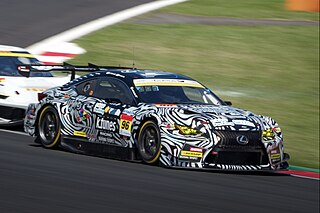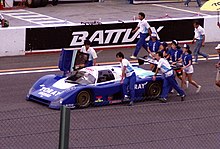
Super GT is a sports car racing series that began in 1993. Launched as the Zen Nihon GT Senshuken (全日本GT選手権), generally referred to as the All Japan Grand Touring Car Championship (JGTC), the series was renamed to Super GT in 2005. It is the top level of sports car racing in Japan.

DENSO Corporation is a global automotive components manufacturer headquartered in the city of Kariya, Aichi Prefecture, Japan.

TOM'S Inc. is an automotive aftermarket parts manufacturer and tuner of Toyota and Lexus vehicles, as well as a factory-backed racing team. The TOM'S head office is located in Tokyo, Japan.
Masanori Sekiya is a Japanese former racing driver, most famous for being the first Japanese driver to win the 24 Hours of Le Mans, in 1995.

Manabu "MAX" Orido is a Japanese professional racing driver.

The 2006 Autobacs Super GT Series was the fourteenth season of the Japan Automobile Federation Super GT Championship including the All Japan Grand Touring Car Championship (JGTC) era and the second season as the Super GT series. It was also the twenty-fourth season of a JAF-sanctioned sports car racing championship dating back to the All Japan Sports Prototype Championship. The season began on March 19 and ended on November 5, 2006, after 9 races.

The Sard MC8-R was a modified and lengthened version of the Toyota MR2 (SW20) built for GT racing by Toyota's SARD works team.

During its history the Toyota Supra has enjoyed considerable success in a variety of different motorsports.

Team Kunimitsu is a racing team founded in 1992 by Kunimitsu Takahashi. The team has competed in the Super GT Series since 1994.

Tokachi International Speedway (十勝インターナショナルスピードウェイ) is a motor racing circuit in Takikubo, Sarabetsu, Hokkaido, Japan.
Dominik Schwager is a German auto racing driver.
The 2012 Autobacs Super GT Series was the twentieth season of the Japan Automobile Federation Super GT Championship including the All Japan Grand Touring Car Championship (JGTC) era and the eighth season as the Super GT series. It also marked the thirtieth season of a JAF-sanctioned sports car racing championship dating back to the All Japan Sports Prototype Championship. The season began on April 1 and ended on November 18, 2012, after eight championship races and a non-championship race.

Masami Kageyama is a Japanese racing driver from Kanagawa Prefecture. His older brother is Masahiko Kageyama who was also a successful racing driver in similar categories.

The 2016 Autobacs Super GT Series was the twenty-fourth season of the Japan Automobile Federation Super GT Championship including the All Japan Grand Touring Car Championship (JGTC) era, and the twelfth season under the name Super GT. It was the thirty-fourth overall season of a national JAF sportscar championship dating back to the All Japan Sports Prototype Championship. The season began on April 10 and ended on November 13, after 8 races.

Le Mans Ltd., headquartered in Shibuya, Tokyo is an automobile parts manufacturer founded in 1967. The original company name was Le Mans Chamber of Commerce. The company is mainly engaged in the development and sales of motorsport parts and the import and sale of race cars overseas.
The 2019 Autobacs Super GT Series was a motor racing championship based in Japan for grand touring cars. The series is sanctioned by the Japan Automobile Federation (JAF) and run by the GT Association (GTA). It was the twenty-seventh season of the Japan Automobile Federation Super GT Championship which includes the All Japan Grand Touring Car Championship (JGTC) era and the fifteenth season the series has competed under the Super GT name. It was the thirty-seventh overall season of a national JAF sportscar championship dating back to the All Japan Sports Prototype Championship. The season began on April 14 and ended on November 24, after 8 championship races & 2 non-championship races.

Sho Tsuboi is a Japanese racing driver for Toyota Gazoo Racing and TOM'S Racing, who currently competes in the Super GT Series GT500 class and Super Formula Championship. Graduated from Surugadai University.

Miki Koyama is a Japanese racing driver, currently racing in the Super GT Series GT300 class as a reserve driver for R'Qs Motor Sports. She is best known for her time racing in the W Series from 2019 to 2021, and for becoming the first woman to win an FIA-sanctioned, all-gender single-seater championship when she won the 2022 Formula Regional Japanese Championship.
The 2020 Autobacs Super GT Series was motor racing championship based in Japan for grand touring cars. The series is sanctioned by the Japan Automobile Federation (JAF) and run by the GT Association (GTA). It was the twenty-eighth season of the Japan Automobile Federation Super GT Championship which includes the All Japan Grand Touring Car Championship (JGTC) era and the sixteenth season the series to compete under the Super GT name. It was the thirty-eighth overall season of a JAF national sportscar championship dating back to the All Japan Sports Prototype Championship.

Morio Nitta is a Japanese racing driver currently competing in the Super GT Series for K-tunes Racing. He is a three-time champion of the GT300 class, winning the championship in 1996, 1999, and 2002.





















